Pistachio Nut Farming
Pistachio (Pistacia vera) farming is a long-term investment that requires specific climatic conditions and meticulous management. It is a high-value crop known for its profitability once established, though it requires patience as trees take several years to bear a significant harvest.
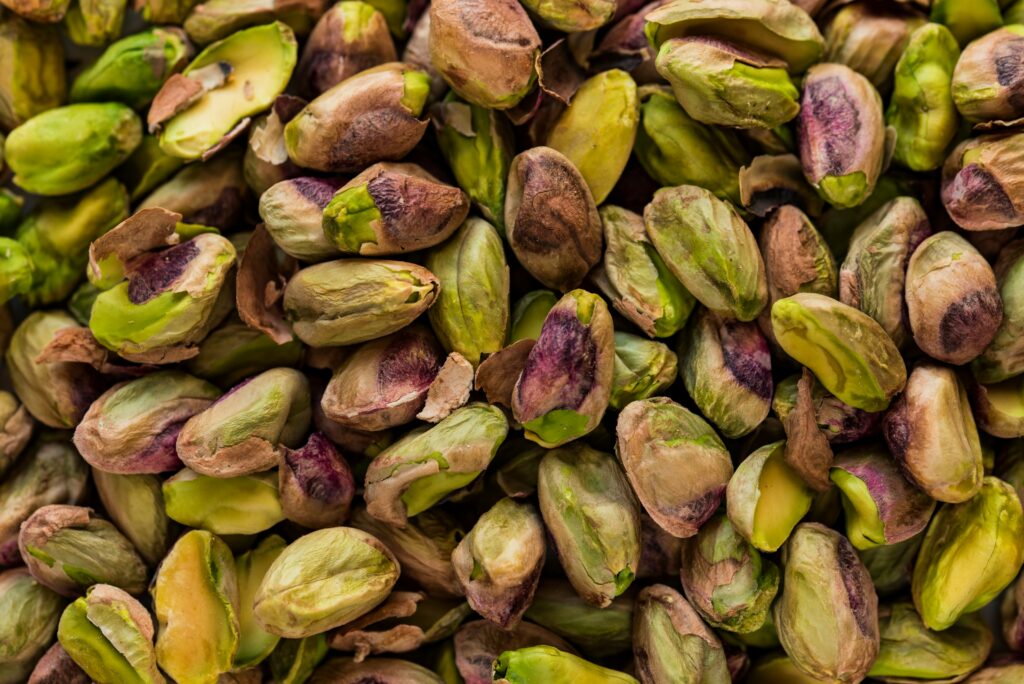
Pistachio nut farming profit per acre is highly promising, as although the initial investment of approximately NRs. 187,600 and an annual maintenance cost of around NRs. 80,000 per acre are required to cover irrigation, fertilizers, pest and disease management, and general upkeep, orchards typically reach the break-even point by the sixth year when cumulative income surpasses total costs.
From the seventh year onward, the farm begins generating substantial net profits, with year-seven earnings of about NRs. 712,000 and peak yields around the tenth year producing profits of approximately NRs. 1,414,000 per acre.
Mature orchards, particularly between years 14 and 25, show alternate bearing patterns, yet even in “Off Years,” profits remain healthy at nearly NRs. 947,000 per acre, while “On Years” can yield up to NRs. 1,984,400 per acre.
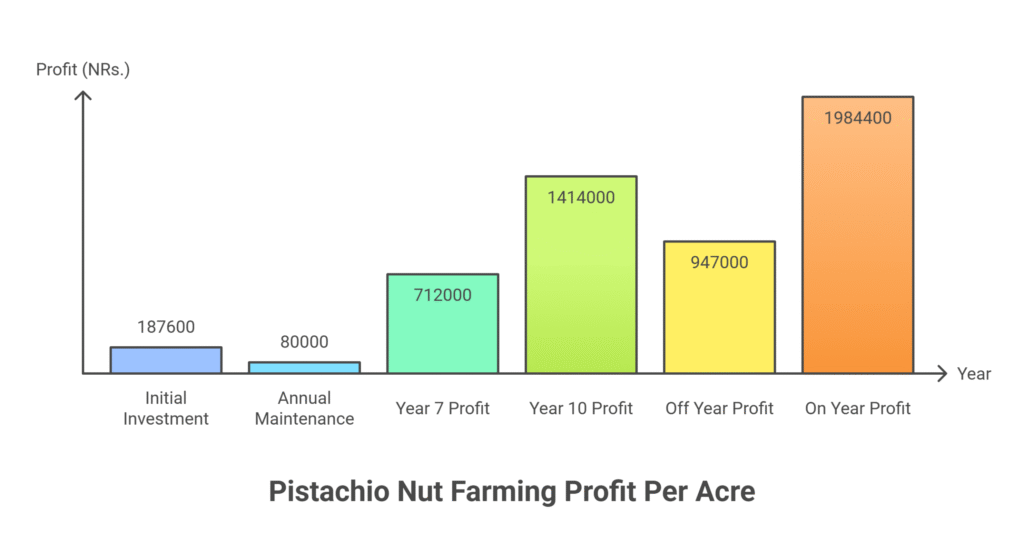
With a productive lifespan exceeding 50 years, pistachio orchards offer long-term, stable, and highly lucrative returns, making pistachio nut farming a sustainable and rewarding agribusiness investment.
Land Preparation
Land preparation for pistachio cultivation is a crucial step to ensure healthy tree establishment and long-term productivity. It begins with deep plowing or subsoiling to break up compacted layers and hardpans, allowing the pistachio’s extensive taproot system to penetrate deeply into the soil and access nutrients and moisture efficiently.
Well-drained soils are essential for pistachios, so this process also improves aeration and reduces the risk of waterlogging. After plowing, the land is thoroughly leveled to facilitate uniform irrigation and prevent water stagnation, which can harm root development. All weeds, stubbles, and residues of previous crops are removed to minimize pest and disease risks while reducing competition for water and nutrients.
Proper land preparation not only creates favorable soil conditions for planting but also ensures better growth, establishment, and long-term orchard management.
Soil Type
Pistachios grow best in deep, sandy loam soils that are well-drained, as these conditions allow their strong taproot system to develop fully and support healthy growth. While the crop is remarkably tolerant of drought and can withstand moderately saline conditions better than many other nut trees, it is highly sensitive to poor drainage and waterlogging, which often lead to root rot and tree decline.
Therefore, selecting soils with good internal drainage is critical for orchard success. The ideal soil pH for pistachio cultivation ranges from 7.0 to 7.8, which is slightly alkaline and favorable for nutrient availability and uptake. Ensuring the right soil type not only promotes vigorous tree establishment but also enhances long-term productivity and nut quality.
Climatic Requirements
Climatic conditions play the most decisive role in pistachio cultivation, as the crop is highly sensitive to variations in temperature, humidity, and seasonal patterns.
Pistachios require long, hot, and dry summers for proper fruit development and maturation, since prolonged heat helps the nuts ripen fully, enhances shell splitting (a desirable commercial trait), and minimizes the risk of fungal infections that thrive in humid conditions.
Equally important are cold winters, as pistachio trees have a physiological need for chilling hours—temperatures below 7°C (45°F)—during their dormant phase.
Depending on the variety, they typically need between 600 and 1,000 or more chilling hours to ensure uniform bud break, healthy flowering, and good fruit set in the following season.
An arid or semi-arid climate is ideal for pistachio orchards, because high humidity and excessive rainfall during the growing period not only increase susceptibility to fungal and bacterial diseases but also reduce nut quality.
Regions with well-defined seasons—cold winters and long, dry summers—are therefore most suitable, making careful site selection essential for achieving high yields and consistent production.
Major Cultivars
| Cultivar | Type | Key Characteristics |
| Kerman | Female | Dominant variety in California; produces large, high-yielding nuts. |
| Peters (Atlas) | Male | Common pollinator; flowers in synchrony with Kerman. |
| Golden Hills | Female | Newer cultivar; high-yielding with good nut quality. |
| Lost Hills | Female | Recently developed; high-yielding with improved traits. |
| Randy | Male | Used as a pollinator; suitable for synchronizing with female cultivars. |
| Tejon | Male | Another pollinator variety for effective cross-pollination. |
| Siirt | Female | Popular Turkish cultivar; valued for high nut quality. |
Propagation
Pistachios are commercially propagated almost exclusively through T-budding or chip budding onto suitable rootstocks, as seed propagation is not used in orchards due to its inability to produce true-to-type plants.
Seedling Rate per Acre
Orchards are typically established by planting grafted saplings, with a general seedling rate of about 112 plants per acre.
Nursery Management
Nursery management for pistachios begins with the selection of appropriate rootstock seeds, commonly from species like Pistacia atlanticaor P. integerrima, which are prized for their inherent resistance to soil-borne diseases.
To overcome seed dormancy and ensure successful germination, these seeds undergo a process called stratification, where they are given a controlled cold treatment. Once prepared, the seeds are sown into meticulously prepared nursery beds where they are cultivated and allowed to grow for an entire season to develop a robust root system.
In their second year of growth, the established rootstocks are then bud-grafted, or budded, with scion wood carefully selected from a mature tree of the desired commercial cultivar; this intricate process combines the resilient rootstock with the superior nut-producing qualities of the scion to create the grafted saplings used for orchard establishment.
Planting
a). Planting Season
Bare-root pistachio trees should be planted during their dormant period, usually in late winter to early spring (mid-February to March). To ensure proper pollination and optimal nut production, orchards should maintain a male-to-female tree ratio of 1:8 to 1:10, meaning one male tree can effectively pollinate eight to ten female trees.
b). Spacing
Pistachio trees require ample space due to their large size, with a common planting distance of 6 m × 6 m.
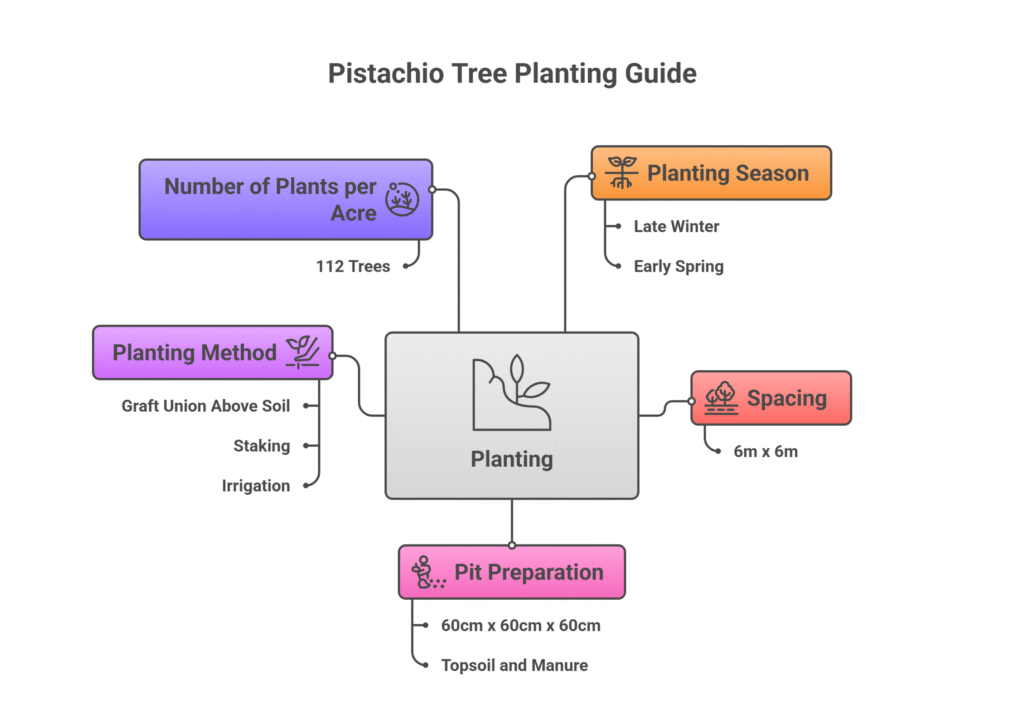
c). Pit Preparation
Dig pits measuring 60 cm × 60 cm × 60 cm and fill them with a blend of topsoil and well-decomposed organic manure.
d). Planting Method
Ensure the graft union remains well above the soil surface. Provide staking for tree support and irrigate immediately after planting.
e). Number of Plants per Acre
An acre can support roughly 112 pistachio trees at 6m x 6m apart.
Intercropping
Intercropping, the practice of cultivating secondary crops between the rows of young pistachio trees, is a viable and strategic practice particularly during the orchard’s initial establishment phase, specifically within the first three to four years before the developing canopy creates significant shade.
This technique typically involves planting low-growing, shallow-rooted crops such as legumes (e.g., beans or lentils) or melons, which are selected specifically to minimize competition with the young pistachio trees for essential resources like water, nutrients, and sunlight.
This practice not only maximizes the efficient use of land but also provides the orchardist with a crucial additional source of income during the non-bearing years while the primary pistachio orchard is maturing towards its productive phase.
Furthermore, intercropping with legumes can offer the added benefit of improving soil health by fixing atmospheric nitrogen, thereby contributing to the overall sustainability of the farming system.
Irrigation
Despite being a naturally drought-tolerant species, regulated irrigation is absolutely essential for achieving viable commercial production and high-quality nut yields in pistachio orchards. To maximize water efficiency and maintain a dry canopy—which is crucial for preventing fungal diseases—trees are typically irrigated using precise systems such as drip irrigation or micro-sprinklers.
The timing of irrigation is critically managed according to the tree’s phenological stages; it is most vital during the nut filling phase, as water stress at this time can severely reduce yield and kernel size.
Conversely, in a key management practice leading up to the harvest, irrigation is strategically reduced and then halted to induce moderate water stress, which promotes the desirable splitting of the shells and prepares the tree for mechanical shaking.
Fertilizer and Manure
Orchard nutrition for pistachio trees is meticulously managed and is fundamentally based on the results of regular soil and leaf tissue analysis to tailor applications to the specific needs of the trees. A general comprehensive fertilization program for bearing tree includes the annual application of 15-20 kg of well-decomposed farmyard manure (FYM) per tree to maintain soil organic matter.
This is supplemented with biofertilizers, specifically a mixture of Azospillum, Phosphate Solubilizing Bacteria (PSB), and Potash Mobilizing Bacteria, with 50 grams of each applied per tree to enhance nutrient availability. Given its high demand, nitrogen is supplied in split doses throughout the growing season, often in the form of approximately 450 grams of ammonium sulphate per tree divided into two applications.
In contrast, phosphorus and potassium applications are determined strictly by soil test results to avoid imbalance. Additionally, zinc supplementation is often a critical component of the program, as deficiencies are common and can significantly impact tree health and productivity.
Weed Control
Effective weed control is vital for the healthy establishment and growth of pistachio trees, especially when they are young and vulnerable. Weeds aggressively compete for essential resources like nutrients, water, and sunlight, stunting the development of the trees and lowering their eventual yield.
A successful management strategy usually integrates several techniques. These include clean cultivation near the trees to eliminate weeds, mechanical weeding to disrupt growth without damaging roots, and mulching to suppress weeds while also retaining soil moisture and improving fertility.
Although herbicides can be part of this approach, they require very careful application to avoid any contact with the tree trunks, as this can cause severe injury or mortality. Consistent observation and prompt action are therefore crucial to keep the orchard free of weeds and support optimal tree growth.
Interculture Operation
Training is a crucial interculture operation performed on young pistachio trees to establish their fundamental architecture. The primary objective is to build a strong, well-spaced scaffold structure of main branches that can support heavy future nut crops and withstand environmental stress.
This is typically achieved by training the saplings to either an open-center system, which creates a vase-shaped tree allowing maximum light penetration into the canopy, or a modified central leader system, which maintains a dominant main trunk with well-spaced lateral branches.
This early formative pruning directs the tree’s energy into developing an ideal and productive framework for its entire lifespan.
Pruning is an indispensable yearly task for sustaining the health and maximizing the yield of established pistachio trees. This selective process entails the careful cutting away of dead, injured, or infected limbs to curb disease and enhance the tree’s vitality.
However, its role extends far beyond simple upkeep. Pruning is vital for preserving the tree’s intended form, facilitating sunlight access to the inner canopy to improve fruit development and bud formation, and regulating the critical equilibrium between new shoot growth and nut production. By doing so, it channels the tree’s resources effectively to promote reliable and superior harvests.
Flowering and Fruit Management
Pistachio trees are dioecious, with male and female flowers produced on separate trees, making successful fruit set completely dependent on efficient pollination. To ensure sufficient pollen transfer while maximizing productive orchard space, a standard ratio of one male tree to every 8–10 female trees is maintained.
Male trees are strategically positioned in a uniform layout—commonly placed as every third tree in every third row—to enable thorough wind-assisted pollen dispersal across all female trees. Unlike in some fruit crops, fruit thinning is not usually necessary, as proper pollination and thoughtful orchard design are generally enough to ensure satisfactory nut development and maximize yield.
Pest and Disease Management
Common Pests
a) Navel Orangeworm (NOW) – Amyelois transitella
The Navel Orangeworm is the most critical pest of pistachios. Adult moths lay eggs on developing nuts, and the emerging larvae bore into them, leaving webbing and frass, which can lead to fungal contamination such as aflatoxin. Effective management focuses on orchard sanitation, particularly removing and destroying overwintering “mummy” nuts, combined with well-timed chemical control.
Pistachio Navel Orangeworm management includes both mating disruption and chemical control. Pheromone dispensers are applied at a rate of 100–150 per acre to confuse male moths and reduce mating. Conventional insecticides are applied at the hull split stage, with recommended doses of Methoxyfenozide (Intrepid 2F) at 0.57–1.14 ml per liter of water, Chlorantraniliprole (Altacor 35WG) at 0.21–0.31 g per liter, Phosmet (Imidan 70-W) at 24–36 g per liter, and Lambda-cyhalothrin (Warrior II) at 0.09–0.14 ml per liter of water.
b). Stink Bugs
Stink bugs feed on pistachio nuts by piercing and sucking the sap, which can cause nut shriveling, staining, and reduced market quality. Infestations are typically higher in late summer and early fall, especially in orchards near weedy areas or other host crops. Monitoring using pheromone traps and visual scouting is essential to determine spray timing.
Insecticide management for pistachio pests includes the use of Bifenthrin (Talstar 10WP or similar) at 0.5–1 ml per liter of water, Lambda-cyhalothrin (Warrior II) at 0.09–0.14 ml per liter, and Malathion 57EC at 10 ml per liter of water.
c). Leaf-footed Plant Bug
The leaf-footed plant bug damages pistachio nuts by piercing them to feed, resulting in kernel necrosis, staining, and premature nut drop. They are most active during late summer and fall. Regular monitoring is critical, and chemical control is generally applied when populations exceed economic thresholds.
Insecticide management can be carried out using Bifenthrin (Talstar 10WP) at 0.5–1 ml per liter of water, Lambda-cyhalothrin (Warrior II) at 0.09–0.14 ml per liter, or Malathion 57EC at 10 ml per liter of water.
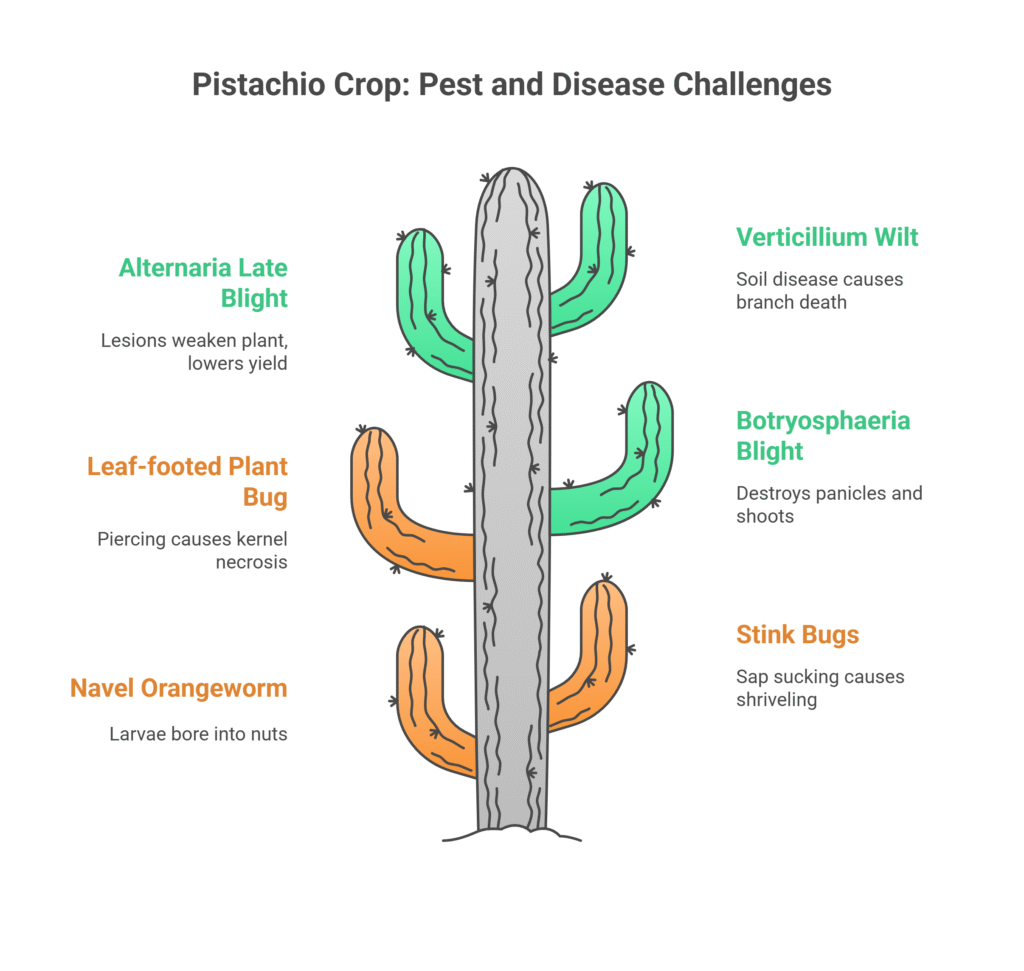
Common Diseases
a). Botryosphaeria Panicle and Shoot Blight (Most Destructive)
This is considered the most serious disease, affecting both panicles and shoots, leading to significant yield losses. Infected panicles show blight symptoms, and shoots may die back, reducing tree productivity. Management involves removing and destroying infected plant parts and applying fungicides such as Copper Oxychloride at 2.5 g per liter of water or Carbendazim at 1 g per liter. Preventive sprays during flowering and early fruit development are highly effective in reducing infection.
b). Alternaria Late Blight
This disease generally appears on leaves and fruits, causing dark, irregular lesions that may coalesce under favorable conditions of humidity and temperature. It weakens the plant, reduces photosynthetic efficiency, and lowers yield quality. Effective control includes spraying Mancozeb at 2.5 g per liter of water or a combination of Mancozeb + Carbendazim (2 g per liter) at intervals of 10–15 days during disease-prone periods. Proper canopy management to improve aeration also helps minimize disease incidence.
Verticillium Wilt
A soil-borne fungal disease called verticillium wilt causes branches to wilt, turn yellow, and eventually die after entering through the roots. Once established, it is hard to control, however maintenance of soil health and preventive actions are essential. Applying 10–20 g of Trichoderma-based biofungicides per plant to the soil aids in pathogen suppression. Furthermore, disease severity can be decreased by soaking the root zone in soil containing 2 g of carbendazim or 3 g of copper oxidation per liter. For long-term management, it is also advised to plant rootstocks that are tolerant or resistant.
Harvesting
Pistachios are harvested in late summer or early autumn(Aug-Sept in Northern Hemisphere) when the hull loosens from the shell and the shell splits naturally. Harvesting is done mechanicallyby shaking the nuts onto catching frames. Hulls must be removed within 24 hours of harvest to prevent shell staining.
Yield
The output of pistachios varies greatly with age and is affected by alternate bearing, in which trees generate a heavier harvest one year and a lower crop the following. In 5–7 years, the first commercial harvest typically starts, yielding 1-2 kg of nuts per tree. Trees attain full productivity in 10–12 years. A robust planting in an established orchard can produce 1,000–1,600 kg or more of in-shell nuts per acre.
Cost of Investment per Acre for Pistachio Farming
| S.N. | Categories | Cost (NRs.) |
| 1 | Land Preparation | 15,000 |
| 2 | Planting Materials | 33,600 |
| 3 | Planting | 5,000 |
| 4 | Fertilizers and Manure | 8,000 |
| 5 | Irrigation (Drip System) | 100,000 |
| 6 | Weed Control (Pre & Post) | 5,000 |
| 7 | Pest & Disease Control | 5,000 |
| 8 | Harvesting | 6,000 |
| 9 | Miscellaneous Costs | 10,000 |
| Total Initial Investment | 187,600 |
Annual maintenance Cost for Pistachio Farming
The annual maintenance cost for pistachio farming from the second year onward is estimated at around NRs. 80,000 per acre, which generally covers expenses such as irrigation management, application of fertilizers and organic manure, pest and disease control, weed management, routine labor charges, and other cultural practices required to sustain tree growth and productivity. This recurring investment is essential to maintain orchard health, ensure consistent yields, and maximize profitability over the long lifespan of pistachio trees.
Income per acre from Pistachio Farming
| Year | Estimated Yield (Kg) | Market Price (NRs./Kg) | Total Income (NRs.) |
| 4th Year | 150 | 1,000 | 150,000 |
| 5th Year | 330 | 1,000 | 330,000 |
| 6th Year | 520 | 1,000 | 520,000 |
| 7th Year | 720 | 1,100 | 792,000 |
| 8th Year | 900 | 1,100 | 990,000 |
| 9th Year | 1,088 | 1,100 | 1,196,800 |
| 10th Year | 1,245 | 1,200 | 1,494,000 |
| 11th Year | 600 | 1,200 | 720,000 |
| 12th Year | 1,360 | 1,200 | 1,632,000 |
| 13th Year | 680 | 1,200 | 816,000 |
| 14th -25th Year+ (On-Year) | 1,588 | 1,300 | 2,064,400 |
| 14th – 25th Year+ (Off-Year) | 790 | 1,300 | 1,027,000 |
Analysis of Pistachio Farming Profit Per Acre
Table 1
| Particulars | Value (NRs.) |
| Initial Establishment Cost (Year 1) | 187,600 |
| Annual Maintenance Cost (from 2nd year onward) | 80,000 |
Table 2
| Year | Income (NRs.) | Cumulative Cost (NRs.) | Cumulative Income (NRs.) | Status |
| 4 | 150,000 | 427,600 | 150,000 | Loss |
| 5 | 330,000 | 507,600 | 480,000 | Loss |
| 6 | 520,000 | 587,600 | 1,000,000 | ✅ Break-even Achieved |
Table 3
| Year | Gross Income (NRs.) | Annual Maintenance (NRs.) | Net Profit (NRs.) |
| 7 | 792,000 | 80,000 | 712,000 |
| 10 (Peak) | 1,494,000 | 80,000 | 1,414,000 |
| 14–25 (On Year) | 2,064,400 | 80,000 | 1,984,400 |
| 14–25 (Off Year) | 1,027,000 | 80,000 | 947,000 |
Initial Investment and Maintenance Cost
The initial establishment cost for pistachio farming in the first year is around NRs. 187,600. From the second year onward, the annual maintenance cost is estimated at NRs. 80,000 per acre, which covers irrigation, fertilizers, pest and disease control, and general upkeep.
Break-even Analysis
By the fourth year, income reaches about NRs. 150,000, but the cumulative cost is around NRs. 427,600, meaning the orchard is still operating at a loss. In the fifth year, income rises to NRs. 330,000, but cumulative investment stands at approximately NRs. 507,600, keeping the balance negative. By the sixth year, however, with an income of NRs. 520,000 and cumulative earnings of 1,000,000 against costs of about 587,600, the orchard crosses the break-even point.
Profit from Year Seven Onwards
From the seventh year, pistachio farming begins generating strong profits. In year seven, the net profit reaches NRs. 712,000 after deducting maintenance costs. By the tenth year, at peak yield, profits rise to about NRs. 1,414,000 per acre.
Mature Orchards (Year 14–25)
Once orchards mature, alternate bearing becomes more evident. In “On Years,” income can reach about NRs. 2,064,400, giving a net profit of nearly 1,984,400 per acre. In “Off Years,” income drops to about NRs. 1,027,000, still resulting in a healthy net profit of around 947,000.
Long-Term Outlook
Pistachio orchards are a long-term investment with the potential to remain productive for more than 50 years. Although alternate bearing reduces yearly consistency, the overall returns are highly attractive. After break-even in year six, net profits range from about NRs. 700,000 to nearly 2 million per acre annually, making pistachio farming a highly profitable venture.
For Almond: Almond farming profit per acre
For Nutmeg: Nutmeg Farming Profit Per Acre
Sources
Food and Agriculture Organization (FAO)
University of California Agriculture & Natural Resources (UC ANR)
European Plant Protection Organization (EPPO)
Punjab Agricultural University (PAU)
Tamil Nadu Agriculture University (TNAU) – Agritech portal
Indian Council of Agricultural Research (ICAR)
Nepal Agricultural Research Council (NARC)
U.S. Department of Agriculture (USDA).
Ministry of Agriculture and Livestock Development (Nepal)
Disclaimer: This crop farming profits assume optimal conditions. Actual results may vary depending on climate, market prices, and farm management practices.
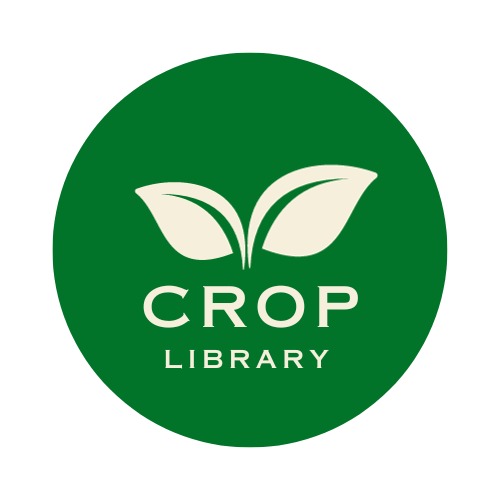
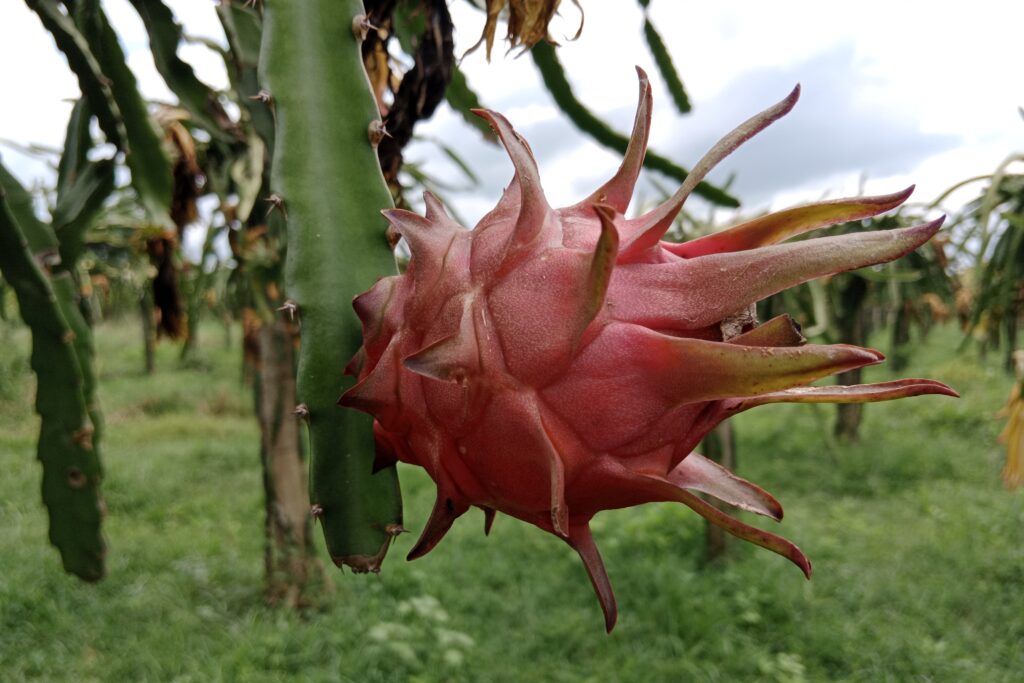
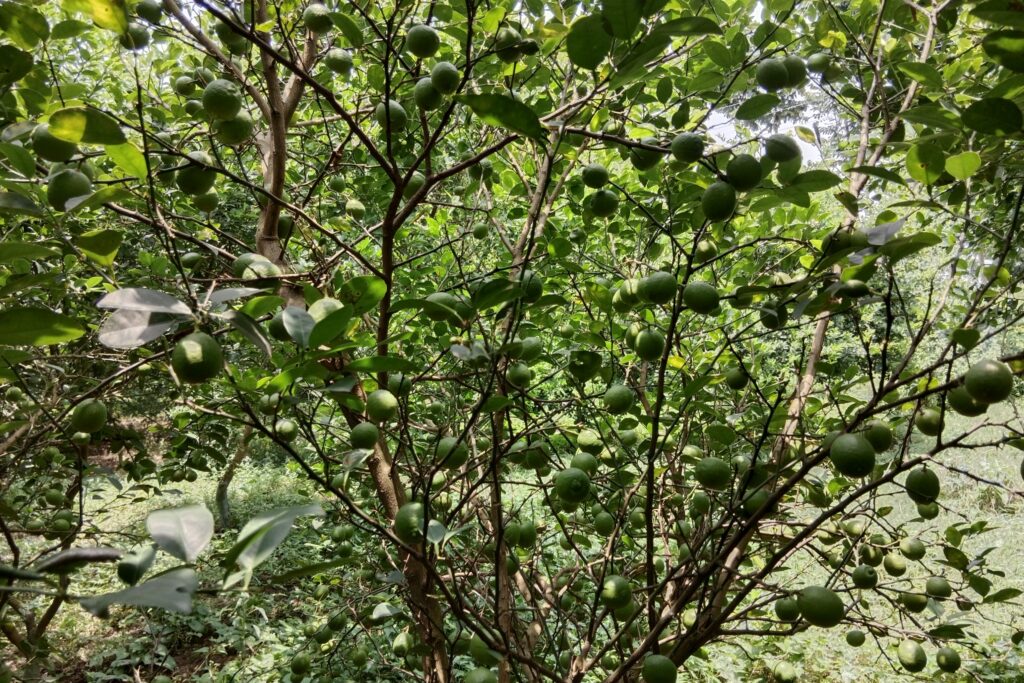
Cooperation – SP05 pistachios, plum and almond harvesting machine – 18,700 eur;SP08A 43200 eur – Serbia
Two to three workers can process two trees per minute with one man.
Dear!
We are a manufacturer of agricultural machinery (fruit and vegetable harvesters).
Detailed information about our products is available on our website: http://www.tresac.co.rs
Best regards,
*38163305765 Petrovic Srbobran ing.el constructor
englis +381654174545 Marija
SZR ELEKTRONIK
Serbia